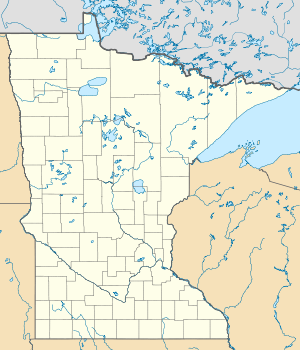Lake Minnetonka
| Lake Minnetonka | ||
|---|---|---|

|
||
| Aerial view of Lake Minnetonka (Wayzata Bay and Lower Lake) | ||
| Geographical location | Hennepin County , Carver County in Minnesota (USA) | |
| Tributaries | Six Mile Creek | |
| Drain | Minnehaha Creek → Mississippi River | |
| Places on the shore | Mound , Wayzata , Deephaven | |
| Data | ||
| Coordinates | 44 ° 56 ′ N , 93 ° 36 ′ W | |
|
|
||
| Altitude above sea level | 283 m | |
| surface | 57 km² | |
| scope | 177 km | |
| Maximum depth | 34 m | |
|
particularities |
flow regulated ( Gray's Bay Dam ) |
|

|
||
| Map of Lake Minnetonka | ||
The Lake Minnetonka is a 5700 hectare lake in the US -Bundesstaat Minnesota . It is located west in the metropolitan area of Minneapolis-Saint Paul . The lake was formed over 10,000 years ago during the melting of the last ice age. Due to its shape with many bays, the shore length is around 177 kilometers.
geography
The Six Mile Creek is the most important tributary of Lake Minnetonka . The water level of Lake Minnetonka and the outflow into Minnehaha Creek , which flows into the Mississippi River in Minneapolis , are controlled in the east of the lake by the Gray's Bay Dam . The flow rate is a maximum of 8495 cubic meters of water per second (up to 100 million liters per day). The area of the lake at 243 meters above sea level is 57 square kilometers, the maximum water depth is 43 meters. The daily evaporation is up to 190 million liters. This results in an average annual evaporation of 43.5 billion liters of water. This is compensated by around 40 billion liters of precipitation and the inflow of 29 billion liters.
Major towns around the lake are Orono , Wayzata , Minnetonka , Excelsior , Shorewood, and Mound .
history
Several hundred years before the discovery by the Europeans, various Indian peoples such as the Dakota , Iowa and Ojibwa settled the land around Lake Minnetonka. The forests around the lake were used as burial places. The first records of the discovery of the lake by Europeans go back to 1822. Back then, 14-year-old Joseph Brown and Will Snelling were canoeing up Minnehaha Creek until they came to the source of the river.
In 1851 the Treaty of Mendota was signed between the Indian tribes and the US government. Accordingly, a total of eight million square kilometers of land became the property of the United States and could be released for settlement. The request of some Indians to leave the area around the lake as a reservation was rejected. For this reason, some chiefs refused to sign the contract, which nevertheless became valid. A year later, Governor Alexander Ramsey gave the lake its name. He chose the word Minnetonka based on "minn-ni-tanka" , which means "great water" in the language of the Dakota Indians . In the same year a dam was built at the drain, Minnehaha Creek. The first settlements were built on the lake and the first hotel was opened in 1853. Some time later, a group of immigrants from New York founded Excelsior on the south bank . Wayzata was founded on the north bank in 1854 , followed by many other townships.
In 1861 the first steamboat , which drove over the Minnetonka Creek from Minneapolis to Minnetonka Mills, went into operation. In 1867 the St. Paul & Pacific Railroad reached Wayzata, bringing large numbers of tourists to the lake. Most of these came to Wayzata by rail and were then transported to other places on the lake by steamboat. Lake Minnetonka had its heyday at the end of the 19th century, when a dense network of steam boats were in operation and grand hotels shaped the landscape around the lake. In 1905, the Twin City Rapid Transit began operating trams from the Twin Cities to the lake. Due to private automobile traffic, the railroad and steam boats increasingly lost their importance in the 20th century.
To this day, Lake Minnetonka is a popular holiday and recreation area.
Web links
- lakeminnetonka.com - History Overview (English)
- A Brief History of Lake Minnetonka (English)
- Minnehaha Creek Watershed District (English)
Footnotes
- ↑ There are, however, various information about the length of the shore. These range from 100 to 140 miles (160 to 225 kilometers). Most sources, however, speak of 110 miles (177 kilometers).


